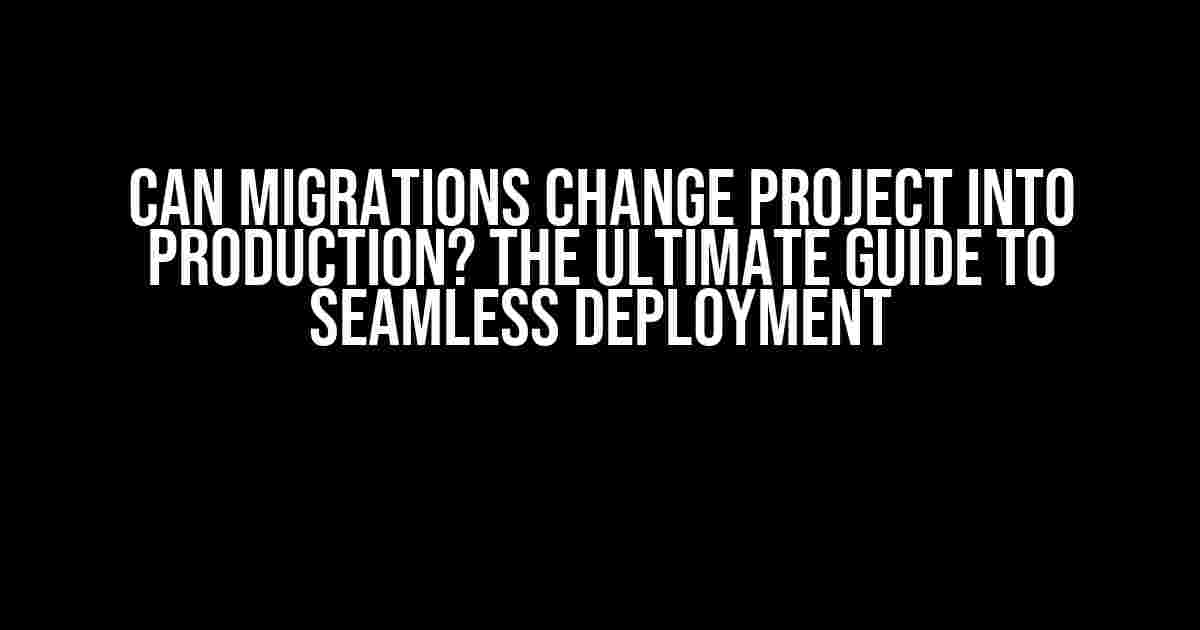Ever wondered how to take your project from development to production without breaking a sweat? Well, wonder no more! In this comprehensive guide, we’ll dive into the world of migrations and explore how they can revolutionize your project deployment process. Buckle up, and let’s get started!
What are Migrations?
In the context of software development, migrations refer to a series of incremental changes made to a project’s database, schema, or architecture to adapt it to new requirements or environments. Think of it like a series of small, intentional steps that guide your project towards its final production-ready form.
The Power of Migrations in Deployment
Migrations offer a neat way to transform your project from development to production by breaking down the process into manageable, testable chunks. By applying these incremental changes, you can:
- Refactor your database schema to optimize performance and data integrity
- Update your codebase to accommodate new features or technologies
- Test and validate individual changes before applying them to production
- Avoid the risks associated with making drastic, sweeping changes to your project
When to Use Migrations
Migrations are particularly useful in scenarios where:
- You’re transitioning from an old database to a new, modern one
- You’re introducing significant architectural changes to your project
- You need to roll out new features or functionality to a production environment
- You’re dealing with complex, multi-step deployments that require careful planning
Step-by-Step Guide to Using Migrations for Production-Ready Deployment
Now that we’ve covered the what, why, and when of migrations, let’s dive into the nitty-gritty of how to use them to deploy your project to production.
Step 1: Assess Your Project’s Current State
Take stock of your project’s current architecture, database schema, and codebase. Identify areas that need improvement, and prioritize the changes you want to make.
+---------------+ | Current State | +---------------+ | Database: MySQL | | Schema: legacy | | Codebase: | | Architecture: Monolithic | +---------------+
Step 2: Plan Your Migration Strategy
Develop a clear roadmap for your migration journey. Break down the process into smaller, manageable tasks, and estimate the time and resources required for each step.
| Task | Description | Estimated Time |
|---|---|---|
| Database Refactoring | Update database schema to modern standards | 2 days |
| Codebase Refactoring | Update codebase to accommodate new architecture | 3 days |
| Architecture Update | Transition to microservices-based architecture | 5 days |
Step 3: Create and Apply Migrations
Using your favorite migration tool (e.g., Flyway, Liquibase, or Alembic), create and apply incremental changes to your project. This might involve:
// Migration 1: Update database schema
ALTER TABLE customers
ADD COLUMN email VARCHAR(255);
// Migration 2: Update codebase
void updateUserInformation(User user) {
// Code updated to accommodate new architecture
}
// Migration 3: Transition to microservices
@Microservice
public class UserService {
// Code refactored for microservices-based architecture
}
Step 4: Test and Validate Changes
Test each migration thoroughly to ensure it hasn’t introduced any regressions or bugs. Validate that the changes meet your project’s requirements and are ready for production.
- Run automated tests to cover basic functionality
- Perform manual testing to cover edge cases and user acceptance criteria
- Review code changes with your team to ensure consistency and best practices
Step 5: Roll Out to Production
Once you’re confident in your migrations, it’s time to deploy your project to production. Apply the final migration, and voilà! Your project is now live and ready for the world to see.
+---------------+ | Production-Ready | +---------------+ | Database: PostgreSQL | | Schema: modern | | Codebase: | | Architecture: Microservices | +---------------+
Best Practices for Migrations
To get the most out of your migration journey, keep these best practices in mind:
- Keep migrations small and incremental
- Test and validate each migration before moving on to the next
- Use version control to track changes and maintain a clear history
- Communicate with your team and stakeholders throughout the process
- Have a rollback plan in case something goes wrong
Conclusion
Migrations offer a powerful way to transform your project from development to production, ensuring a seamless and stress-free deployment process. By following the steps outlined in this guide, you’ll be well on your way to migrating your project to its final production-ready form.
Remember, migrations are all about incremental changes, testing, and validation. With patience, persistence, and the right tools, you can overcome even the most complex deployment challenges.
So, what are you waiting for? Start planning your migration journey today, and watch your project thrive in production!
Frequently Asked Question
When it comes to taking your project to the next level, migrating to a new environment can be a game-changer. But can migrations really change a project into production? Let’s dive into the details.
Can migrations really turn a project into production?
Absolutely! A well-planned migration can seamlessly transition your project into a production-ready environment. It’s like taking your project from a prototype to a polished, scalable, and secure solution ready for real-world use.
What are the key benefits of migrating a project to production?
The benefits are numerous! A successful migration can improve performance, enhance security, increase scalability, and provide better resource utilization. It can also reduce costs, improve user experience, and give you a competitive edge in the market.
How long does a typical migration process take?
The duration of a migration process depends on the complexity of the project, the size of the team, and the resources available. On average, a migration can take anywhere from a few weeks to several months. However, with careful planning and execution, you can minimize downtime and ensure a smooth transition.
What are some common challenges faced during a migration?
Some common challenges include data inconsistencies, compatibility issues, and unexpected downtime. Additionally, inadequate planning, insufficient resources, and poor communication can also hinder a successful migration. But with the right expertise and strategy, you can overcome these obstacles and achieve a seamless transition.
Do I need to involve my entire team in the migration process?
While it’s essential to keep your team informed about the migration, you don’t need to involve everyone in the process. Identify the key stakeholders and subject matter experts who can contribute to the migration strategy, and involve them in the planning and execution phases.


